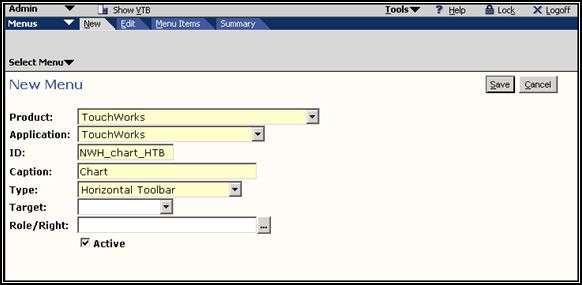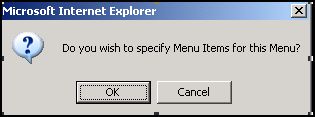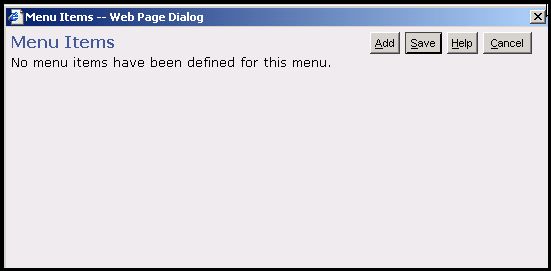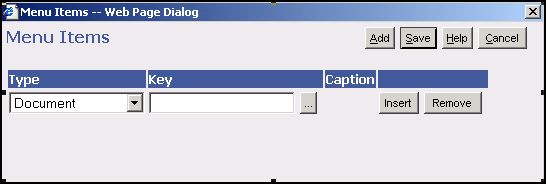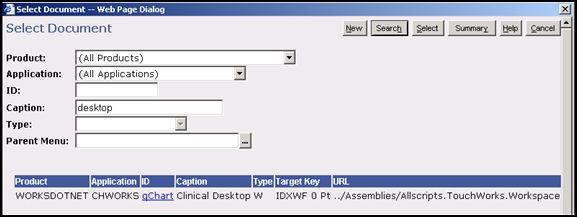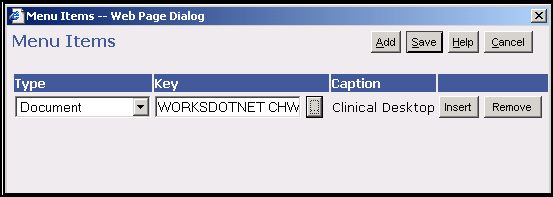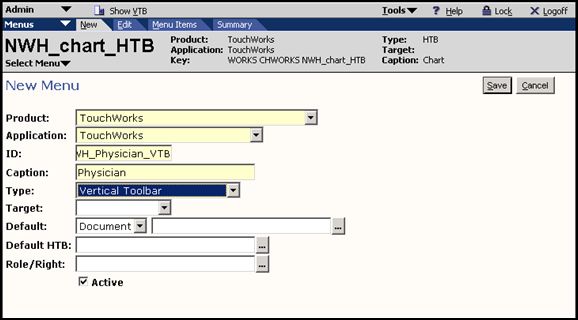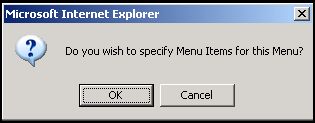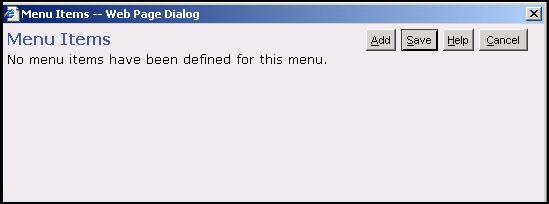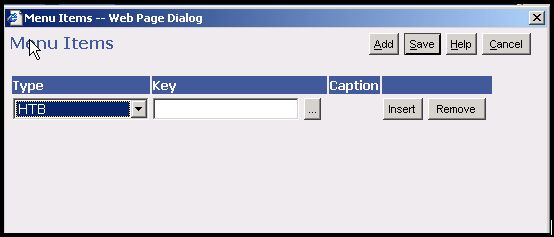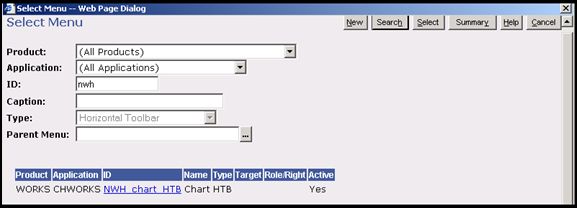Editing and Building Menus
Building Menus
Before you begin
Before you begin building menus, make sure you have reviewed information in the Wiki about Creating TouchWorks Users so that you can build menus that are tailored to the roles of your organization.
What you need to know
Menus consist of thee distinct components. The VTB Vertical Tool Bar, The HTB Horizontal Tool Bar and the document.
The components are shown broken out Here:
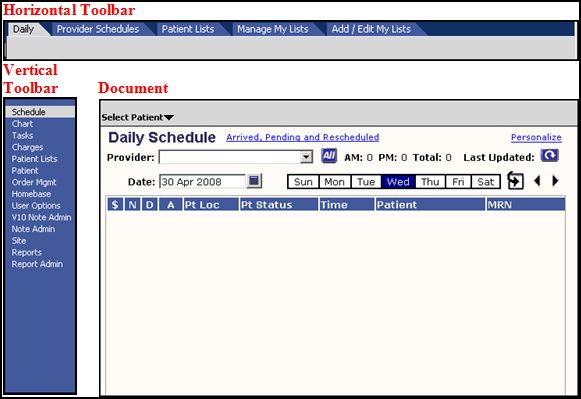
Documents are pre-delivered from Allscripts.
Both the Vertical and Horizontal toolbars are configurable to meet the needs of the client.
Captions is the term for names given to menu items – “schedule” is the selected caption in the above example.
Select an item from the Vertical Tool Bar (in the above example, “Schedule”) This displays a Horizontal Toolbar of Tabs (Daily, Provider Sced., Pat. List, etc.) It also displays the default document for “Schedule” which in this example is the Daily Schedule.” Clicking on the tabs on the horizontal tool bar, a user can move between documents.
Best Practice
It is best practice to make menus role specific. (ie. The menu items for a nurse may differ from the menu items for a physician or a resident)
When creating menu components you really want to steer away from using the default menus that Allscripts provides. During upgrades and service packs, the default menus may get overwritten to their default settings and remove any changes you may have made.
It is best to create a standard process for naming menu items within TouchWorks. When creating a new menu item, the ID should be created using the following format or something similiar:
<Client Menmonic>_<Role>_<Menu Type>_<Phase>
For Example: GHS_Clinician_WP_P1 - This would be the clinician workplace for Phase 1
GHS_ClinicianChart_HTB_P1 - This would be the Chart HTB for a clinician for Phase 1
Using a naming convention such as this ensures that everyone on your team can understand what each menu item pertains to and also makes it easier to support in the future. If for instance you determine that after going live, it would be much easier for physicians to have the batch signing page on their chart HTB, it is very easy to find the clinician chart defnition and add that item without effecting any other users.
When Building menus, the best practice is to work from the bottom up, building the HTB tabs for documents first, then building the VTB.
Building Menus, Step by Step
- Navigate to the Admin Workplace
- Select Menus from the Vertical Toolbar
- Select New from the Horizontal Toolbar
- Always select TOUCHWORKS for the Product and Application
- Create an ID for the menu you are creating. This ID should follow the best practice Naming Convention. The ID needs to be a unique identifier. This should look like: ClientMneumonic_Descriptior_Menutype. To create a Horizontal tool bar for New World Health for Chart it would appear like this:
NWH_chart_HTB
- Create a caption. Captions are the words that appear in the Vertical Toolbar that the user uses to navigate to the Horizontal tool bar. This what the user sees. Captions can be re-used.
- Then select the type of menu you are creating.
- Click Save in the upper right hand corner.
- Click ok
- Select Add (top right hand side of the dialog box)
- Under “Type” use the dropdown menu to select the appropriate child menu item.
- If you are creating a horizontal tool bar your type will be “Document”
- If you are creating a vertical tool bar your child type will be “HTB”
- If you are creating a workplace, your child type will be “VTB”
In this example we will select Document
- Click on the ellipsis
- Type a keyword in the caption field and click on search to look for documents.
- Highlight the document you want and click on the select button in the upper right hand corner of the screen.
We have now added the clinical desktop document and Tab to the Horizontal tool bar captioned “chart.”
To add another document, click add and repeat the process above. When finished, click on save.
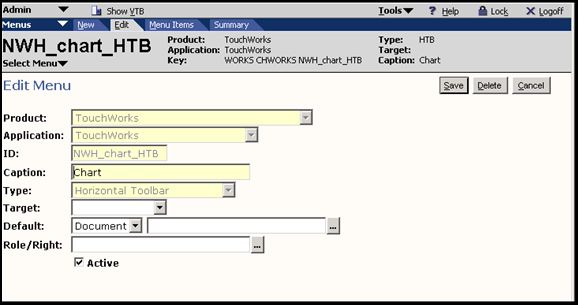
Once saved, you can navigate to the “Edit” tab at the top of your screen. Here in the Banner you can see what menu you are working on (this is similar to how you see a patient name when you are working in Touchworks on the front end.)
- Select a default document. This will be the document that the provider wants to see first when they make their selection from the vertical tool bar.
- Continue to build all of the HTBs that you will need for this specific role (nurse, provider, front desk)
- Once all of the HTBs are complete, then you can follow the same steps to build the Vertical Tool Bar.
- Select Touchworks for the Product and application
- Create a unique identifier for the ID using the naming convention
- Select Vertical toolbar for Type
- Click on the save button in the upper right hand corner
- Click OK
- Click Add
- Select HTB for Type in the Menu items Dialog box
- Click on the ellipses to select your menu
- Search for the HTBs that you built using your unique identifiers
- Highlight the HTB that you created and click on Select in the upper right hand corner of the dialog box.
- Select all of the HTB items that you want to appear in the VTB that you are creating. Then click on the save button in the upper right hand corner of the screen.
The Vertical and Horizontal Toolbars have been created. To become functional these menus must assigned to users using TWAdmin. From the Vertical Toolbar in the TWAdmin workspaces, select TWUser Admin, select a user, scroll down to workplaces, and set the workplace to the user.


